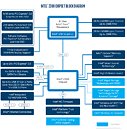- Joined
- Oct 9, 2007
- Messages
- 47,585 (7.45/day)
- Location
- Dublin, Ireland
| System Name | RBMK-1000 |
|---|---|
| Processor | AMD Ryzen 7 5700G |
| Motherboard | ASUS ROG Strix B450-E Gaming |
| Cooling | DeepCool Gammax L240 V2 |
| Memory | 2x 8GB G.Skill Sniper X |
| Video Card(s) | Palit GeForce RTX 2080 SUPER GameRock |
| Storage | Western Digital Black NVMe 512GB |
| Display(s) | BenQ 1440p 60 Hz 27-inch |
| Case | Corsair Carbide 100R |
| Audio Device(s) | ASUS SupremeFX S1220A |
| Power Supply | Cooler Master MWE Gold 650W |
| Mouse | ASUS ROG Strix Impact |
| Keyboard | Gamdias Hermes E2 |
| Software | Windows 11 Pro |
Intel released a product brief of its premium mainstream-desktop (MSDT) chipset, the Z390 Express. Positioned above the Z370 Express, the chipset has an exhaustive feature-set. It supports current 8th generation Core "Coffee Lake" processors, and is ready for the next-generation. Like all other 300-series chipsets, the Z390 interfaces with the LGA1151 processor over a DMI 3.0 chipset-bus. Much like the Z370, it features 24 downstream PCI-Express gen 3.0 lanes. Its storage setup remains unchanged from the Z370 - six SATA 6 Gbps ports with AHCI and RAID support; and up to three 32 Gbps M.2/U.2 connectors.
The differences begin with the chipset's integrated USB connectivity. The Z390 Express directly puts out six 10 Gbps USB 3.1 gen 2 ports, and ten 5 Gbps USB 3.1 gen 1 ports. If that's not a lot, it also puts out fourteen USB 2.0 ports (a total of 30 USB ports). Another major feature is Intel SmartSound technology, which the document specifies as an "audio/voice offload" DSP. This should, in theory, reduce the CPU's load in processing the audio stack. At the physical level it's still the company's "Azalia" HD audio bus wired to an audio CODEC with close to zero native signal processing. Perhaps some of that processing is done inside the chipset. The concept appears to be borrowed from edge-computing, and triggered by the rise in voice-command interface, so the chipset can natively process speech-to-text conversions.

With the Z390 Express, Intel is also updating the platform's networking feature-set. The chipset supports a 1 GbE MAC interface, and recommends motherboard manufacturers to include an Intel Wireless-AC 9560 card, with 802.11ac and Bluetooth 5. Almost every Z390 motherboard will feature wireless networking, and most of them will include Intel's recommended WLAN card pairing. No new CPU overclocking features are detailed in the document.
View at TechPowerUp Main Site
The differences begin with the chipset's integrated USB connectivity. The Z390 Express directly puts out six 10 Gbps USB 3.1 gen 2 ports, and ten 5 Gbps USB 3.1 gen 1 ports. If that's not a lot, it also puts out fourteen USB 2.0 ports (a total of 30 USB ports). Another major feature is Intel SmartSound technology, which the document specifies as an "audio/voice offload" DSP. This should, in theory, reduce the CPU's load in processing the audio stack. At the physical level it's still the company's "Azalia" HD audio bus wired to an audio CODEC with close to zero native signal processing. Perhaps some of that processing is done inside the chipset. The concept appears to be borrowed from edge-computing, and triggered by the rise in voice-command interface, so the chipset can natively process speech-to-text conversions.

With the Z390 Express, Intel is also updating the platform's networking feature-set. The chipset supports a 1 GbE MAC interface, and recommends motherboard manufacturers to include an Intel Wireless-AC 9560 card, with 802.11ac and Bluetooth 5. Almost every Z390 motherboard will feature wireless networking, and most of them will include Intel's recommended WLAN card pairing. No new CPU overclocking features are detailed in the document.
View at TechPowerUp Main Site


